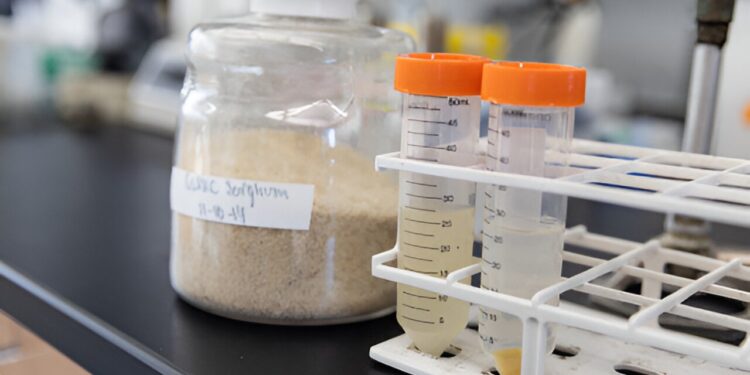Bacteria grown on a sorghum lignin solution secrete products like PDC into the surrounding medium, which must be separated from the cells (right), which contain carotenoids, yielding two valuable products. Credit: Chelsea Mamott
We often look to the smallest forms of life to help us solve the biggest problems: microbes help make food and drinks, cure disease, process waste, and even clean up pollution. Yeast and bacteria can also turn plant sugars into biofuels and chemicals traditionally derived from fossil fuels – a key part of most plans to slow climate change.
Now, researchers at the University of Wisconsin-Madison have engineered bacteria that can produce two chemicals at the same time from underutilized plant fibers. And unlike humans, these multitasking microbes can do both equally well.
“To my knowledge, this is one of the first times you can make two valuable products in a single microbe simultaneously,” says Tim Donohue, professor of bacteriology at UW-Madison and director of Great Lakes Bioenergy Research Center.
The discovery, detailed in an article in the journal Applied and environmental microbiologycould help make biofuels more sustainable and commercially viable.
“In principle, the strategy reduces net greenhouse gas emissions and improves the economic situation,” says Donohue. “The amount of energy and greenhouse gases you need to make two products in one jar will be less than it will take to make two jars to make one product in each jar.”
Every molecule counts
The quest to replace fossil fuels with sustainable alternatives relies on extracting the greatest possible value from renewable biomass. Just like in petrochemicals, every molecule counts: low-volume, high-value products help keep fuel prices more affordable.
One of the largest barriers is a part of the plant cell wall called lignin. Lignin is the world’s most abundant source of renewable aromatic carbons, but its irregular structure makes it notoriously difficult to break down into useful components.
That’s why GLBRC scientists studied a bacteria called Novosphingobium spiceivorans (sometimes called simply Novo), which is capable of digesting many lignin components and is relatively easy to genetically modify.
In 2019, researchers designed a strain of Novo capable of producing a key ingredient in plastics like nylon and polyurethane, known as PDC. More recently, a team in Donohue’s lab discovered another modification that allows Novo to make a different plastic ingredient called ccMA.
But they didn’t stop there.
“We’re not going to solve our carbon emissions problem by making just two products,” says Ben Hall, a recent doctoral graduate who contributed to the research.
Ben Hall, PhD in genetics. student, holds a mixed sample of microbes and carotenoids, in Tim Donohue’s lab. Credit: Chelsea Mamott
Donohue’s team used genomic modeling to come up with a list of potential products that could be made from biomass aromatics. Topping the list was zeaxanthin, one of the organic pigments known as carotenoids.
Carotenoids, which give carrots, pumpkins, salmon and even flamingos their distinctive hues, are used as nutritional supplements, pharmaceuticals and cosmetics and have a cumulative market value of tens of billions of dollars per year.
The researchers knew that Novo had the genes to produce another carotenoid with little commercial value. Based on the bacteria’s genome sequence, they suspect that zeaxanthin is a stepping stone to this less valuable carotenoid in the process cells use to make complex molecules. It was simply a matter of modifying the right genes to stop the digestive assembly line at the most valuable product.
By removing or adding selected genes, they engineered strains that produced zeaxanthin as well as other valuable carotenoids (beta-carotene, lycopene, and astaxanthin) when grown on a commonly found aromatic compound in lignin.
Next, the team showed that the engineered bacteria could produce the same carotenoids from a liquor made from crushed and processed sorghum stalks, a solution containing a mixture of aromatics that many industrial bacteria cannot digest. .
One jar, two products
Hall then wondered what would happen if he combined the genetic changes needed to make PDC and a carotenoid in the same microbe.
The resulting strains produced both PDC and the target carotenoid, without perceptible loss in yield. Better yet, bacteria accumulate carotenoids within their cells, which must be separated from the solution containing the PDC that they secrete.
“We already separate media cells,” says Hall. “Now we would have a product from both.”
The next steps are to test whether the engineered strains can produce carotenoids and ccMA simultaneously, which Donohue believes, and to engineer strains to improve yields under industrial conditions.
While there are lucrative markets for each of these products, Donohue and Hall say the real value of this discovery lies in the ability to add multiple functions to this biological platform.
“For me, it’s both the strategy and the products,” Donohue says. “Now that we’ve done that, I think it opens the door to see if we can create other microbial frameworks that allow two products to be made.”
More information:
Benjamin W. Hall et al, Production of carotenoids from aromatics and pretreated lignocellulosic biomass by Novosphingobium spiceivorans, Applied and environmental microbiology (2023). DOI: 10.1128/aem.01268-23
Provided by University of Wisconsin-Madison
Quote: Scientists engineer bacteria to make two valuable products from plant fibers (December 20, 2023) retrieved December 21, 2023 from
This document is subject to copyright. Apart from fair use for private study or research purposes, no part may be reproduced without written permission. The content is provided for information only.



